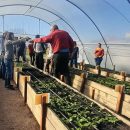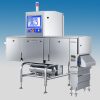NEPG Warns Of Imminent Supply–Demand Breakdown As EU Potato Area Hits Record Levels

Potato growers across the North-Western European Potato Growers (NEPG) zone are facing one of the toughest seasons in recent memory, as a surge in planted area and favourable early conditions push the 2025 harvest to record volumes. According to the organisation, the resulting oversupply has driven free-buy prices to historic lows and forced tens of thousands of tonnes out of the food chain.
In its latest update from Gembloux on 5 September 2025, NEPG reports that farmers planted 7% more potatoes in 2024 – an increase of 37,000 hectares – driven by expanding processing capacity, consecutive seasons of strong demand signals, and higher contract prices. This pattern intensified further in spring 2025, adding nearly 40,000 hectares for consumption potatoes across Belgium, Germany, France and the Netherlands (EU-04). The total area reached 608,000 hectares, again up 7% year-on-year.
Trial digs indicate a projected 2025 crop of around 27.3 million tonnes, the highest ever recorded for the zone and 11% above 2024, equivalent to an additional 2.65 million tonnes.
However, NEPG states that this growth has rapidly turned into a structural imbalance. “A significant portion of the harvest cannot be stored, and tens of thousands of tons have already been redirected to animal feed, biogas plants, or composting facilities,” the organisation notes.
A Growth Crisis Turning Into A Financial One
Despite higher planted area and a strong crop profile, farm-level economics are deteriorating sharply. NEPG warns that agricultural production costs are “among the few that do not decrease”, and nothing suggests improvement in 2026. After widespread financial losses this year, the organisation expects a substantial reduction in planted area next season, though the magnitude remains uncertain.
“We are currently experiencing a true growth crisis: in 2025, a supply crisis, which could very well turn into a crisis of demand as early as 2026 if growers no longer have the economic capacity to keep up,” NEPG states. The imbalance between supply and demand “began this year”, and restoring equilibrium in 2026 is essential, it adds.
Call For A Chain-Wide Approach
The organisation stresses that greater coordination across the entire value chain will be necessary to correct course. “The NEPG stresses the importance of more and continued dialogue throughout the supply chain,” the update says. It reiterates its longstanding position that “production must meet demand, not run ahead of it” and underscores the need for processors, traders and growers to share clear development outlooks.
As planting decisions for 2026 are being made, NEPG urges producers to focus strictly on sustainable, economically viable production. “Produce what you can in a sustainable way and preserve your resources,” the organisation advises.
The group also points to rising exposure to climate-driven risks: potato cultivation is becoming “not only riskier and more expensive, but also putting growing pressure on the natural resources it relies on: soil, water, and biodiversity”. Safeguarding this base is described as essential for long-term agricultural viability.
















